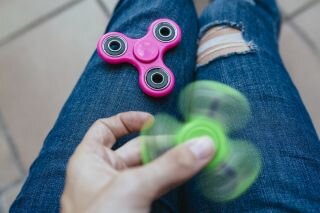We all fidget. For some of us, that means shaking our leg, twirling our hair, biting our nails, or chewing the back of our pen. While many people might think these activities are a distraction, research actually shows that if these actions are properly directed, they can sharpen a person’s focus and enhance learning.
Fidget toys are self-regulation tools to help with calming, attention, focus, and active listening. They allow the ‘just right’ amount of sensory input to calm a person’s nervous system, allowing them to channel their attention and focus more readily. They are commonly used to increase tactile input and promote movement which can be essential for students and professionals alike. In addition to the improved learning benefits, fidget toys can also reduce anxiety and stress, enhance dexterity, improve coordination and fine motor skills and assist in the development of the small muscles in the hands.
The brain stem is what alerts us and helps us to stay regulated. The brain needs to wake up and stay awake when expected to attend. Some children’s brains can wake up but not sustain. Some need help to even awaken. This is where movement and the use of fidgets can help. Movement, through the legs or the hands such as spinning a fidget spinner, can help open up the communication from the body to the brain sending signals to awaken and alert.
Research shows that most children learn better when their hands are active and funneling expandable energy in a manner that allows them to better focus on what they are trying to learn. In a recent case study, the positive effects of fidget toys were observed. The result was a 10% increase in certain academic scores among students who used fidget toys. Even more impressive was that students diagnosed with ADHD saw an increase of 27% in the academic scores. The study concludes that the use of fidget toys can benefit the learning process in all students but especially in those with learning disabilities.
Fidgets can be successfully introduced into the classroom with basic rules and with an overall understanding of the benefits for all those present. It is recommended that teachers create customized rules tailored specifically to their classroom and grade level. The following are a few suggestions for introducing fidgets into a new environment:
Explain that fidgets are a learning tool not a toy
The fidget is for the intended user only, and should not distract or interfere with others learning
When fidgets are not in use, they need to be kept out of sight
There are many different types of fidget toys, ranging from squeezable stress balls to bendable sticks to malleable putty. There are even scented tools for those who gravitate towards using scented fidgets for calming, focusing, attaining, and maintaining that "just right" level of arousal. These could include fidgets like scented kneadable erasers, sensory squares, and even scented putty.
In summary, fidgets can be an essential tool to supporting a child’s learning environment. It is our hope at Champion Pediatric Therapy that you find this information useful and can incorporate the use of fidgets to help your child, or educate others about their benefits.


